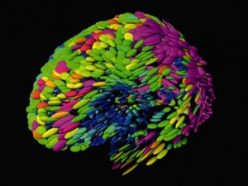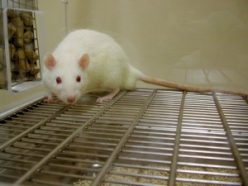Open eyes, dozing minds
Scientists find that rats that stay up late are neither fully asleep nor fully awake

The difference between sleeping and being awake seems simple enough. You know someone is sleeping because his eyes are closed, he’s lying down and inactive, he doesn’t answer your questions, and he might be snoring. People who are awake, on the other hand, have open eyes, can get things done, are responsive to questions and generally don’t snore. If you were to look at a group of animals, you could probably tell which were asleep and which were awake.
But a new study suggests sleeping may be more complicated and less obvious than that. When researchers kept animals up late, the critters seemed to be wide awake, even though tests showed parts of their brains were sleeping.
In the experiment, scientists studied brain activity in sleep-deprived rats. The animals were kept up when they normally would have been sleeping. During that time, the rats’ eyes stayed open. But their brains were not fully functioning: Some brain cells, called neurons, were working, while others dozed.
When an animal is awake, neurons send messages to each other in the form of tiny electrical pulses. While an animal sleeps, these pulses change: Neurons cycle on and off.
The scientists measured the electrical activity of rat neurons with an electroencephalogram, or EEG. Each rat in this experiment had two electrodes in its brain. Electrodes picked up and recorded electrical activity, which the EEG reported as patterns that researchers could read.
After the rats had been kept awake for hours, they played and did tasks — but the EEG showed that some of their neurons were catching zzzzs. In other words, some neurons in the awake rats’ brains shut off as though the animals were sleeping.
The tired rats also had trouble completing difficult tasks, such as reaching through a hole in a wall for a sugar pellet. (The task requires animals to reach and turn their paws, which is considered difficult for rats.) The researchers found a connection between a rat’s success and which brain cells fell asleep. If the sleeping neurons were in a part of the brain that the rat needed for getting the sugar, the animal had difficulty with this task.
Scientists study rats and other animals because their brains are similar to humans’. If the brains of tired people behave like the brains of tired rats, sleep-deprived people also may run into trouble — saying the wrong thing, making mistakes while driving or making bad decisions.

Even though a person might feel sleepy, “nobody would be able to tell there was anything wrong with you,” Giulio Tononi told Science News. Tononi, who led the recent study, is a neuroscientist at the University of Wisconsin–Madison. Neuroscientists study the structure and function of the brain and the nervous system. They often try to understand which parts of the brain correspond to behaviors or activities.
Scientists used to believe that one part of the brain was in charge of sleeping and being awake. But in the past 20 years, a number of studies — including this one — suggest that sleep may not be so simple. Many researchers now suspect that sleep starts in single cells and then spreads throughout the brain. Which means not all cells sleep at the same time, and recognizing the difference between being awake and being asleep can prove challenging.
Unless someone is snoring. Then it still seems fairly simple.
POWER WORDS (adapted from the New Oxford American Dictionary)
electroencephalogram (EEG) A test or record of brain activity. An EEG device reports the electrical activity in the brain as a series of waves that can be read and interpreted by scientists.
neuroscience The scientific study of the brain and nervous system, their structures and functions.
neuron A specialized cell that transmits electrical impulses to other cells.
electrode A conduit, or channel, that allows electricity to leave or enter an object
conductor Something that can conduct electricity.
snore A snorting or grunting sound in a sleeping person’s breathing.







